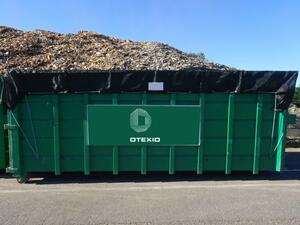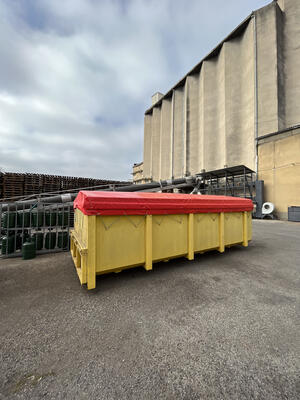What are the requirements for tarping truck dumpsters?
OTEXIO reminds you of the rules regarding tarping containers and the risks involved when these rules are not adhered to.

While the use of a tarp is not explicitly required, the article specifies that any load capable of overflowing outside the vehicle, whether at a stop or during transport, must be securely fastened. The law also requires the driver of a truck or trailer to take all necessary precautions to ensure that loaded materials or transported goods do not pose any danger or harm on the road. In the case of debris, green waste, or bulk materials, the use of a tarp is implicitly obligatory: tarping the container, using either a waterproof tarp or netting depending on the transported materials, helps secure the load and prevents losses due to wind, speed, and road irregularities. Note that the Highway Code also mandates meticulous attachment of the tarp: it must be securely fastened to the vehicle, not protrude beyond its contours, and not drag on the ground.
Whether it's a container, a van, or a trailer, the driver of a vehicle with inadequately secured load is subject to a third-class offense, which can result in a fine of up to 450 euros. Vehicle immobilization is also possible in case of non-compliance.
Tarping containers is a necessary safety measure, sometimes the only one that effectively protects the load, as mandated by law. The choice of fastening systems, as well as the type of tarp or net, is up to the driver, as long as it fulfills these safety obligations: all precautions must be taken to protect users and the environment from the harm that transported materials can cause.
Take a look at our complete range of made-to-measure nets.


Container Tarping: Legal Implications
Securing the load of containers is mandated by the Highway Code, article R312-19.While the use of a tarp is not explicitly required, the article specifies that any load capable of overflowing outside the vehicle, whether at a stop or during transport, must be securely fastened. The law also requires the driver of a truck or trailer to take all necessary precautions to ensure that loaded materials or transported goods do not pose any danger or harm on the road. In the case of debris, green waste, or bulk materials, the use of a tarp is implicitly obligatory: tarping the container, using either a waterproof tarp or netting depending on the transported materials, helps secure the load and prevents losses due to wind, speed, and road irregularities. Note that the Highway Code also mandates meticulous attachment of the tarp: it must be securely fastened to the vehicle, not protrude beyond its contours, and not drag on the ground.
Consequences of Non-Compliance
The primary risk is safety-related: failing to adhere to the precautions required by the Highway Code poses a risk of causing serious harm to other road users. Materials escaping from a container directly endanger trailing vehicles, and this danger increases with speed. Material lost on the road can also cause accidents by forcing drivers to change their trajectory to avoid them. Additionally, certain materials pose an environmental hazard.Whether it's a container, a van, or a trailer, the driver of a vehicle with inadequately secured load is subject to a third-class offense, which can result in a fine of up to 450 euros. Vehicle immobilization is also possible in case of non-compliance.
Tarping containers is a necessary safety measure, sometimes the only one that effectively protects the load, as mandated by law. The choice of fastening systems, as well as the type of tarp or net, is up to the driver, as long as it fulfills these safety obligations: all precautions must be taken to protect users and the environment from the harm that transported materials can cause.
Take a look at our complete range of made-to-measure nets.